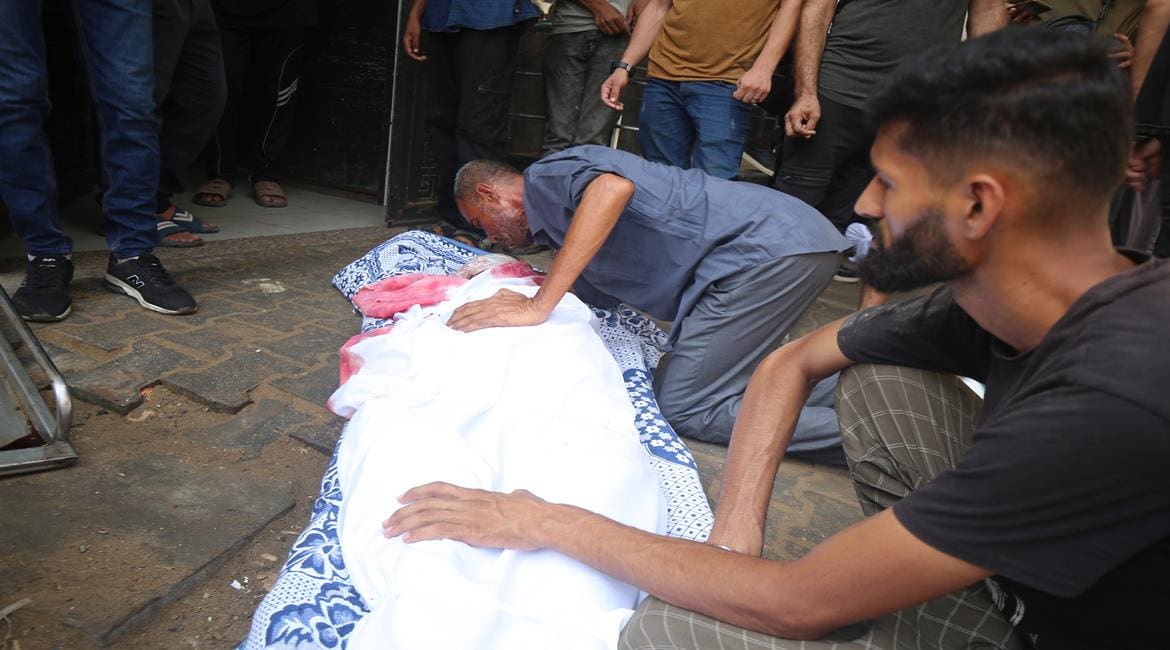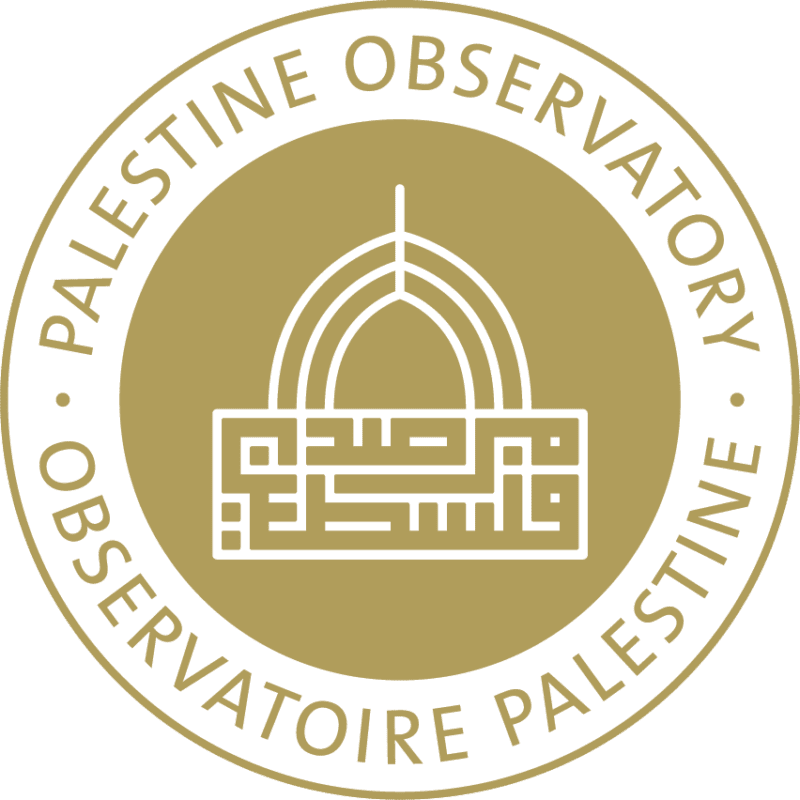The Occupation Forces Kill 86 People Waiting for Food in One Week, and 222 Died of Hunger

People bid farewell to the body of a child killed by Israeli forces at Al-Shifa Hospital in northern Gaza.
Palestinian Press and Information Agency (PNA)
Ramallah, August 12, 2025
The Israeli occupation forces killed six Palestinian journalists in the Gaza Strip, bringing the number of journalists killed since the Israeli aggression on the Strip to 242. This is an attempt to conceal its crimes, which amounted to 4,994 between August 5 and 11, 2025, across the occupied Palestinian territories. The assassination of journalists is part of a policy of creating chaos, which is increasing through selective killings targeting every corner of hope in the Gaza Strip.
The Organization of Islamic Cooperation’s Media Observatory on Israeli Crimes against Palestinians recorded 566 Palestinians murdered and 3,564 injured during the aforementioned period. 549 people were murdered in the Gaza Strip, and civil defense personnel recovered 17 bodies. The total number of Palestinians murdered from October 7, 2023, to August 11, 2025, reached 62,528, and 162,625 were injured during the same period.
The number of Palestinians murdered among those waiting for aid reached 86 people over the past week, as the Israeli occupation army targeted the tents of displaced people in the Atyaf camp near the aid distribution centers in Al-Mawasi, and the occupation forces killed five aid security personnel in the central Gaza Strip. The incident ended with an aid truck overturning, killing 22 Palestinians who had gathered to receive aid amidst the chaos created by the Israeli occupation forces to exacerbate the famine.
Israeli settlers closed a road junction east of Jericho, preventing the passage of aid trucks coming from Jordan to the Gaza Strip. Meanwhile, the death toll from starvation has reached 222 Palestinians, including 101 children.
Meanwhile, Palestinian government sources in the Gaza Strip said that the aid that recently entered the Strip covers only 3% of the population’s needs.
The humanitarian developments came as Human Rights Watch confirmed that the Israeli occupation forces bombed 500 schools housing displaced persons in various areas during their aggression on the Gaza Strip over the course of the aggression. Meanwhile, the Israeli occupation government approved a plan to invade Gaza City as a prelude to occupying the entire Gaza Strip, a move that portends a catastrophic situation and more widespread and horrific war crimes.
In the West Bank, Israeli occupation forces carried out 333 raids over the past seven days, during which they demolished 14 homes in Al-Quds and Bethlehem, 8 tin shacks in Jericho, and confiscated the contents of a number of tents before removing them in the village of Yarza in Tubas. They also demolished a park, a hut, and walls in the village of Al-Judeira in Al-Quds, a commercial facility and a café in Ramallah, and a commercial store in Bethlehem. They removed a water tank and a water line used for irrigation in the village of Yarza in Tubas, and sealed 7 springs and a water spring with cement in the town of Adh Dhahiriya in Hebron. They bulldozed two plots of agricultural land and a room near the village of Artas in Bethlehem, and confiscated a bulldozer in Hebron. They also demolished a school under construction, funded by the French Development Agency, in the village of Aqaba in Tubas. The forces served notices to vacate several homes and agricultural pens, demolish retaining walls, and uproot olive and grape trees within an area of 40 dunams. The owners were given 10 days to implement the decision in the village of Khirbet Beit Sakariya, Bethlehem.
Settlers stormed the Bab al-Rahma Cemetery, adjacent to the eastern wall of Al-Aqsa Mosque, smashing the headstones of several graves and performing Talmudic rituals several times last week, amid daily incursions into Al-Aqsa mosque by Israeli extremists.
The number of arrests of Palestinians in the West Bank over the period monitored by the OIC media observatory reached 135, including 5 children in Jenin, Tulkarm, and Hebron, and a child was injured in Jericho. Settlers also beat a child in Ramallah. The number of settler attacks in the West Bank reached 80 attacks during which settlers burned agricultural lands in the villages of Rammun, Deir Jarir and Turmus Ayya, residential tents in a Bedouin community near the village of Ras Karkar in Ramallah, an agricultural pen and 8 olive trees, and vandalized a water well in the town of Zawiya in Salfit. They cut tree branches on farms in the Qawawis area, the Khallet Ali Ghneim area, and the town of Surif in Hebron, the village of Al-Mughayyir, the village of Farkha in Salfit, the east of the town of Azzun in Qalqilya, and the town of Asira ash-Shamaliya in Nablus. They also cut down 140 trees in the town of Nahalin in Bethlehem, and 100 grape trees in the town of Susiya, in Hebron.
Settlers grazed their sheep on the lands of the village of Yatta, east of the village of Yatta in Hebron, Kafr Malik in Ramallah, the village of Farkha, and the Al-Auja Shalal community, and poisoned the heads of sheep in the Al-Auja Shalal community, which led to their death.
Settlers dug up and vandalized a water line, cutting off water supplies to residents of the village of Umm al-Khair in Hebron. They also raided the village of Bziq in Tubas, breaking into the village council building and destroying its contents. Settlers also seized a car in the town of Ur al-Tahta in Ramallah.
In the same context, the number of settlement activities reached 18, as the OIC media Observatory noted that the occupation forces are working side by side with the settlers to establish new settlement outposts every day. They paved a settlement road and erected pillars, with the aim of establishing a settlement outpost near the village of Kisan in Bethlehem. Settlers paved a settlement road in the lands of the town of Hizma in Al-Quds, bulldozed lands and placed mobile homes on them, with the aim of establishing a settlement outpost in the area of the shrine of Nabi Saleh in Hebron. They bulldozed lands overlooking the plain of the town of Beit Furik and the village of Beit Dajan, with the aim of expanding a settlement outpost in the village of Salem, and bulldozed an area south of the town of Bani Naim, with the aim of establishing another outpost.
Settlers erected a tent and a flagpole in the village of Deir Ammar, in an attempt to establish a settlement outpost, in addition to a tent on land near the Yitzhar settlement in Nablus. Others erected a tent in the Masafer town of Yatta. Settlers re-erected tents near the entrance to the village of Beit Dajan in Nablus in an attempt to re-establish a settlement outpost after its removal. Settlers established another outpost in the Shalla al-Auja cluster, where they seized a pen and laid the foundations for building tin pens. Others erected mobile homes in the town of Teqoa. Settlers attempted to establish a settlement outpost on one of the hills of the village of At-Tuwani in Hebron. They seized an area of land in the village of Dhahr al-Abed, bulldozed land in the areas of Shaqiq al-Dhiban and Hariqat al-Hamaimeh in the village of Rafat in Salfit, and bulldozed land south of the town of Dura, with the aim of expanding a settlement outpost. Others paved a settlement road near the Ayoun al-Haramiyeh junction and to the Jabal Tal al-Batin area, south of the town of Sinjil. They bulldozed land with the aim of paving a road from a settlement outpost that was established on the hills of Khirbet Masoud in Jenin. They also cut down a number of olive trees, and others began establishing a settlement outpost, by erecting tents near the entrance to the town of Atara in Ramallah after paving a dirt road leading to the area. Israel Finance Minister Bezalel Smotrich and the head of the northern West Bank settlements, accompanied by settlers, stormed the ruins of the “Tarsla” site next to the “Sanur” settlement, which was evacuated in 2005 near the town of Jaba, with the aim of returning the settlers to the site.
